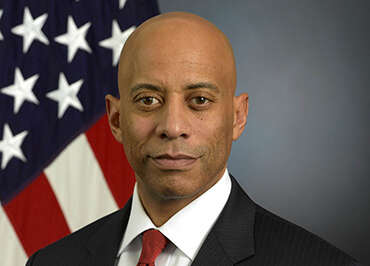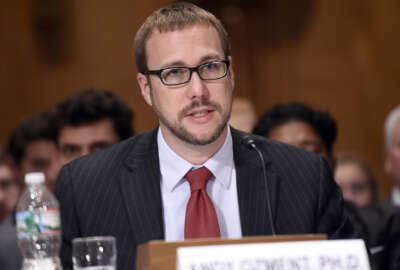DHS researchers leverage innovation to head off terrorism
DHS Science and Technology chief Dr. Reginald Brothers discusses the need to leverage all sources of innovation to stave-off future threats of terrorism.
Charged with heading-off the threat of terrorism here and from abroad, it’s difficult to comprehend the breadth of the mission given the Department of Homeland Security (DHS). With technology and threats evolving rapidly, it’s like looking into a crystal ball and coming up with answers to questions that haven’t yet been asked. But that’s the job Reginald Brothers faces every day.
Brothers, the DHS Undersecretary for Science and Technology, heads the agency’s Science and Technology Directorate (S&T), which leverages the resources of innovators in government, industry, academia and international partners to stave off threats of a mass shooting, a dirty bomb attack, a biological attack, terrorism in the air, poisoning of the food supply, cyber attacks, threats to the electrical grid — and more. It’s a sobering reality.
“We have an incredibly large mission-set, and a limited budget,” said Brothers in an interview with Nicole Ogrysko for the Federal Drive with Tom Temin. “The challenge is to decide what we actually do research on.”
To facilitate the process, Brothers said the agency has established integrated product teams (IPTs) to coordinate R&D efforts across DHS in six areas: aviation security, counter-terrorism, border security, biological/radiological/nuclear threats, incident management and cybersecurity.
“Then we took those areas and came up with a fine-grained set of challenges, and published those challenges so our industry partners can help us come up with solutions,” Brothers said.
That publication, released in August, provides a public summary of the first-year’s results of the DHS strategy.
Engaging Industry in innovation
A large part of the strategy is to invest in accelerators to help develop S&T research partners.
“We realized we have to develop a strong, enthusiastic industrial base,” said Brothers. “We wondered if we could develop early stage companies.”
To engage the entrepreneurial world, Brothers said S&T did an experiment dealing with wearables to help first responders who typically carry outdated and heavy equipment. What they were looking for was innovative ideas for developing technology such as body-worn electronics, advanced sensors, and integrated voice and data communications embedded in a responder’s gear.
“We had about 100 companies apply, 25 were selected and 18 actually came out the other end,” said Brothers. In the end, Brothers said 50% actually received follow-on funding, with three of them now actually selling into the first-responder marketplace. “We’ve linked them up with larger companies so they can have scalability and develop strong distribution channels.”
“One of our concerns with these start-up companies is whether we can develop sustainable businesses that have commercial and homeland security applicability, “said Brothers. “So far it looks pretty good. We’re starting our second round.”
Working with start-ups can be challenging. They may be technologically savvy, but they are put off by the idea of a lengthy and cumbersome government contracting process. To help them cut through the red tape, Brothers’ directorate has developed what he calls an “Other Transactions Solicitations Mechanism.” It takes advantage of what’s known as the Other Transactions Authority (OTA), a special vehicle used by federal agencies for advancing research and prototyping by non-traditional businesses (those that don’t usually do business with the government).
“It helps us do business with companies that don’t have the systems that larger companies already have in place,” said Brothers.
S&T has also streamlined the solicitation process. After filling out a relatively short 10-page application, and having it vetted by subject matter experts, the applicants are invited in to deliver a 15-minute “Shark Tank” presentation that mimics the popular television program on which entrepreneurs try to sell their ideas to a panel of investors.
“After that you get a thumbs-up or a thumbs-down, and — if successful the company — gets its money within 30 days,” said Brothers.
Brothers described the process as good for the contractor as well.
“The advantage they get is they have a mentor who essentially walks them through the process, introduces them to some of the larger companies, and gets the advantage of having us test and develop their products in operational environments to see how well their product actually works,” he said.
The process also is a positive experience for the larger companies, who get the chance to discover products and innovators they might not otherwise have found.
Lessons learned
Brothers said becoming more engaged with the creative community has made him realize that it’s spread much more broadly than in the past.
“There was a time when government was the investor in applied research and development,” he said. “Then industry took on that responsibility. Now, we’re seeing a lot of the ground-breaking research in the smaller, newer companies. So we’ve had to ask ourselves ‘How do we open our aperture wide enough to find these companies?’”
Brothers said he had a revelation on where to look for new innovators during a conversation with a venture capitalist in California.
“He noted there are companies who are creating apps for dating and restaurants, because those are the kinds of things they are interested in, and that’s where they see their marketspace,” he said. “But, when these developers are brought really hard and important problems — like those at DHS — they want to solve those problems, too.”
That’s exactly what Brothers found. And he said it’s the biggest lesson he’s learned in the first year of the IPT process — that solving the issues DHS faces in the future will require a broad spectrum of innovators.
“And it’s not in just in Silicon Valley,” he said, “it’s across the country, and it’s not just start-up companies. It’s larger companies, it’s academia, it’s laboratories, it’s everybody. It’s an environment where creative people are aware of our problems, and are incentivized to work on our problems.”
Two IPT Examples
Brothers spoke briefly about two of the focus areas S&T has been charged with developing: incident management and cybersecurity.
“If you think about the capabilities the Internet of Things brings to us, resilience — or the capability of a community to respond to a natural or man-made disaster — is important, and there are a lot of issues,” Brothers said.
Specifically, he cited the need to develop a broad definition of what resilience means to the different stake-holders and ask how you make sure that happens in an effective way for city managers.
In defending against the problem of cyber attacks, Brothers lamented the mentality of forming a “perimeter defense,” instead of recognizing the need for a different paradigm.
Brothers said the growth of the Internet of Things, cyber criminals, and a growing dependence on digital devices have brought with them a much broader attack surface that people are just starting to think about.
“We’re seeing moving target defenses, the use of analytics and machine learning to solve problems, so I think you’re seeing a more nuanced and sophisticated viewpoint of cybersecurity, taking it from the IT world to the cyber-physical world,” Brother said.
The good news, said Brothers, is that people are starting to think about it.
“I just hope we’re thinking about it quickly enough.”
Copyright © 2025 Federal News Network. All rights reserved. This website is not intended for users located within the European Economic Area.




